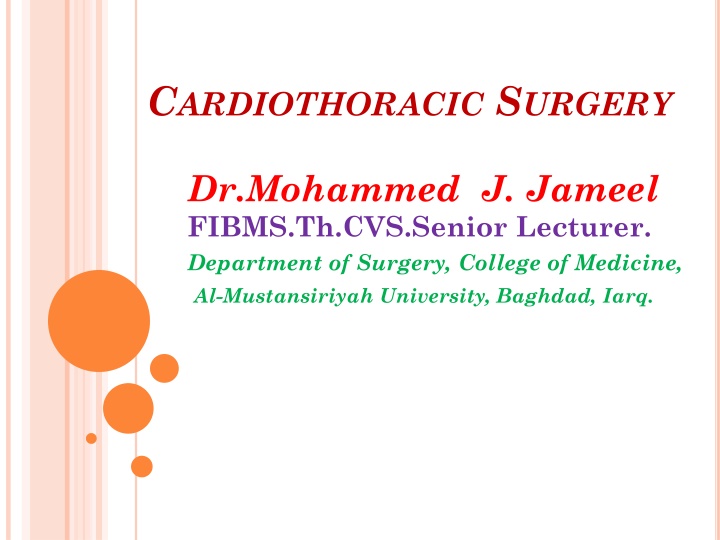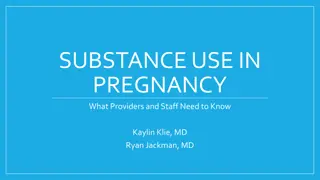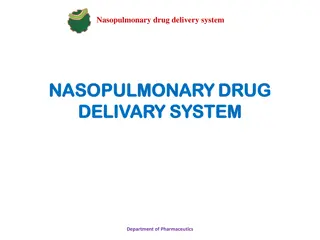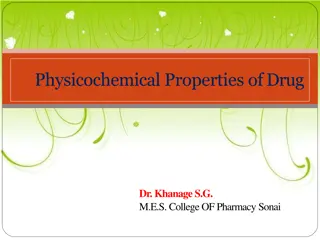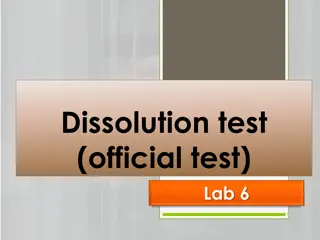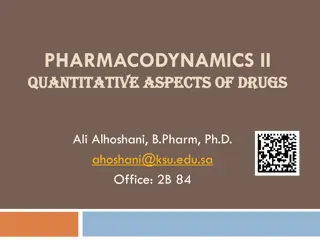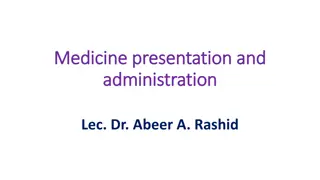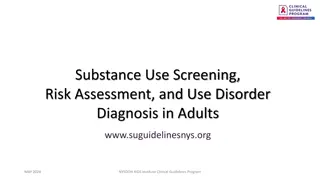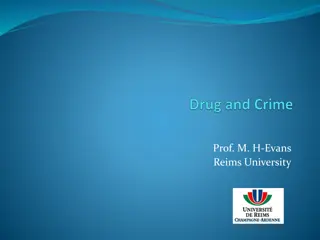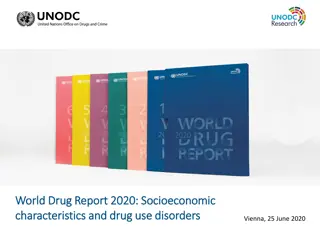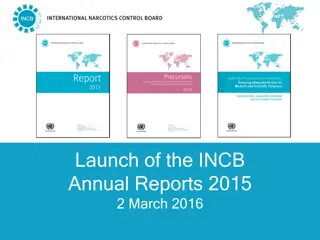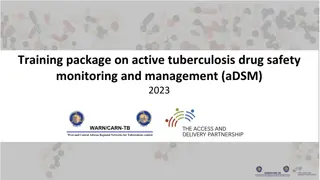Importance of Drug Substance and Formulation in Biopharmaceutics
Physicochemical properties, dosage form, and route of administration are key factors affecting drug performance and efficacy. Biopharmaceutics explores these relationships to ensure optimal drug delivery and therapeutic outcomes.
Download Presentation

Please find below an Image/Link to download the presentation.
The content on the website is provided AS IS for your information and personal use only. It may not be sold, licensed, or shared on other websites without obtaining consent from the author.If you encounter any issues during the download, it is possible that the publisher has removed the file from their server.
You are allowed to download the files provided on this website for personal or commercial use, subject to the condition that they are used lawfully. All files are the property of their respective owners.
The content on the website is provided AS IS for your information and personal use only. It may not be sold, licensed, or shared on other websites without obtaining consent from the author.
E N D
Presentation Transcript
CARDIOTHORACIC SURGERY Dr.Mohammed J. Jameel FIBMS.Th.CVS.Senior Lecturer. Department of Surgery, College of Medicine, Al-Mustansiriyah University, Baghdad, Iarq.
LEC: 6 Hydatid Disease of The Lung :- Is commonly caused by Dog Tape Worm known as Ecchinococcus granulosus which lives in the dog intestine ( Primary host ) and it shed eggs which may contaminate grass and Vegetables these may be ingested by sheep or human ( Secondary host ) and when the ova reach small intestine the Embryo hatch and penetrate the intestine wall and lodge in the liver or lung and develop into Primary Hydatid Cyst .
Pathology :- The cyst wall is about 3 mm thickness and consist of two layers , the external called the Ectocyst which is white laminated semi permeable layer and the internal germinative layer The Endocyst whose cells produce scolices ,clear hydatid fluid and the external layer. The cyst grow much faster in the lung than in the other organ even to large size with minimal reversible compression of lung parenchyma, after removal of the cyst loss of lung volume may be insignificant, in 70% of cases lung cyst is solitary. A pericyst or capsule forms around the cyst and consist of host fibrous tissue and compressed lung parenchyma it sticks to the cyst without adhesion so the surgeon can separate them easily.
Clinical featuers :- Patient infected with P.H.C. usually remain asymptomatic ( when the cyst is intact ) and the cyst continue to grow and they are discovered incidentally when a CXR done as a screening or for non resolving chest infection. Rupture of the cyst represents the Main Danger to the patients life, mostly The H.C. ruptures into the bronchus and may lead to suffocation, haemoptysis, pneumonitis, abscess, bronchiatasis the patient present with productive cough with salty taste sputum and cough up a Grape Like whitish membrane, these are the daughter cysts, anaphylaxis may occur from Hydatid fluid, in10% of cases rupture occur to pleural cavity leading to Pneumothorax, Empyma and Pleural secondary H.C.
Dx:- CXR show different pictures according to the stage of H.C :- Intact H.C:-Rounded homogenous opacity with thick boarders Intact H.C in communication with bronchus: - air will just compress the cyst known as Signet Ring Appearance . Ruptured H.C :- when the Endocyst ruptures and air enters inside it giving The Water Lilly Appearance . Expectorated H.C :- when the whole content of cyst was coughed out an empty cavity will appear on CXR Infected H.C :- seen as a heterogeneous opacity from infected endocyst and pus inside the cavity. CT scan will help to delineate the size and site of lesion and the presence of bronchial communication . Classification :- The Informal Working Group on Echinococcosis ( WHO-IWGE) proposed a standardized classification based on the state of the activity of cyst G 1 active group :- cyst > 2 cm and often fertile G 2 Transition group :- cyst start to degenerate because of host resistance or Rx but may contain viable protoscolices G 3 Inactive group :- degenerated , calcified ,unlikely contain viable protoscolieses.
Surgical Rx :- Since the Medical Rx of no proven value surgery is mostly required, surgery become urgent when cyst ruptures to bronchial tree, when haemothorax or haemoptysis develop, when a hepatic cyst penetrates through diaphragm. Methods of surgical Rx are :- 1- Enucleation method in which the visceral pleura and lung parenchyma incised till pericyst is reached which also incised widely trying to remove the endocyst intact 2- Aspiration Evacuation method in which the cyst is punctured by blood giving set to evacuate it s fluid by gravity then the endocyst removed then the remained cavity sterilized by 10% Iodine. 3- Ruptured H.C with damaged lung tissue may require resection of part of lung e.g. Wedge Resection ,Segmentectomy, Lobectomy, in all methods any site of air leak must be sutured.
Indication of surgery in Mx of Pulmonary T.B:- 1. Complication from previous thoracic surgery to Rx T.B. 2. Failure of medical Rx leading to progress of disease, intra cavitary aspergellosis. 3. Complicated T.B with Massive haemoptysis, bronchiactasis . 4. Extra Pulmonary thoracic involvement. 5. T.B Fibrous Empyma. 6. Need for histopathologic examination for definitive Dx.
Massive Haemoptysis: - Is defined as expectoration of > 600 ml of blood with in 24 hour, the rate of bleeding necessary to produce respiratory compromise is highly dependant on the individual's prior Respiratory status. The Lung has 2 sources of blood supply:- 1. Low pressure pulmonary A. system 2. High pressure bronchial A. system which arise from Thoracic Aorta. Massive Haemoptysis is mostly Due to bleeding from bronchial A. Or from pulmonary A. exposed pathologically to high Pressure of bronchial A.
Etiology: - Is usually Secondary to inflammatory process which cause destruction and erosion of vascular structure leading to bleeding, these factors are classified to:- 1. Pulmonary causes :- Like pulmonary parenchymal diseases e.g. bronchitis, bronchiactasis , T.B , Lung Abscess , pneumonia , Cavitary fungal infection, Pulmonary Embolism and Infarct,Trauma, Neoplasm,A-V malformation. 2. Extra pulmonary causes: - Drugs, Mitral Stenosis, congestive heart failure , coagulopathy. 3. Iatrogenic e.g intrapulmonary catheterization.
Rx :- Priorities in Mx of Massive H. 1. Achieve respiratory control and prevent asphyxia 2. Localize and control sites of bleeding. 3. Determine the cause and percent of recurrence. Scenario1:- Significant , persistent, but not massive bleeding :- in such case the Pt. is able to clear secretion or blood with own respiratory reflex . Mx :- 1. ICU admission, bed rest, sedation, pt. must sleep with the affected side down when it is known. 2. Large I.V Line + humidified O2 +aerosolized adrenaline 3. monitor arterial blood gases . 4. I.V Antibiotics, correct abnormal blood coaguloathy. 5. I.V Vasopressin 20u/15 min followed by 0.2u/ min infusion. CT chest help to localize lesion. Bronchoscopy help to Dx air way abnormality, localize site of bleeding Bronchial A. angiography and Embolization settle Dx and provide Temporary acute control of bleeding, sometimes P.A angio may be necessary.
Scenario 2 :- Persistant Massive Bleeding :- 1. Immediate ETT to control ventilation and suction. 2. Rigid bronchoscopy to Dx bleeding sites and then to advance the bronchoscope to non bleeding side to ventilate Pt. + ice N/S Lavage of bleeding side 3. Blocking of Main stem Bronchus of bleeding side by Double Lumen ETT or by intubation of the non affected bronchus with Single Lumen ETT , the best way is by use of Bronchial Blocker which is inflated and left in place for 24 hours and then the area re-examined by re- bronchoscopy and then to do Bronchial A Embolization. Surgical intervention :- most cases of bleeding can stop by above mentioned measures Sec 1:- requires further evaluation by CT Scan , PFTs Sce 2 :- requires surgical intervention in same admission and it is individualized acc. To 1. Source of bleeding , 2. Pt. medical condition , 3. Pulmonary Reserve , in 10% of cases the operation must be done Emergently. Indication for Surgery 1. Presence of Fungal ball 2. = = Lung Abcess 3. = = Significant cavitary Lesion 4. Failure to control bleeding
